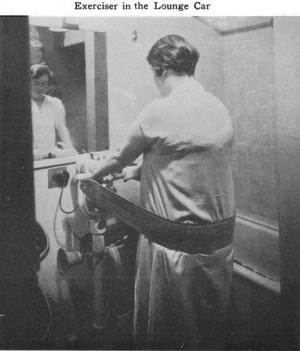Wednesday Bubble: sexual desire in midlife
[youtube=http://www.youtube.com/watch?v=-bjNHzU81qY]
Since I’ve embarked on this blog, I’ve run across numerous studies and articles discussing sexual dysfunction and the lack of/declining sexual desire in women entering midlife and menopause. I’ve written quite a few posts about data that suggest that ingesting hormones can help to reverse these trends as well as a post that focuses on the often overlooked health aspects. If you’ve not read them, I encourage you to do so.
However, this post is not about me; it’s about you. It’s also excellent fodder for your partners and I hope that they derive some important tidbits.
I ran across some fascinating research in the online ahead of print edition of the Journal of Sexual Research that will hopefully burst a few bubbles about desire, more specifically, how women (versus researchers) define and characterize sexual desire and whether there is a huge difference between women with and without female sexual arousal disorder (FSAD, the inability to attain or maintain a sexual excitement (genital lubrication, swelling etc.).
The researchers, who based their study on one-one-one interviews with 22 women, mean ages 45 to 55, noted several challenges when characterizing sexual desire:
- Is it a state or action?
- Is it spontaneous and responds to a stimulus?
- Does it precede, follow or is it indistinguishable from sexual arousal?
They added that for women in midlife, social context is also important; mass media, for example, creates unrealistic expectations and culturally perfect images that are not easily recreated in real life or in midlife. Notably, the distorted views that midlife women have towards their bodies have been shown to influence sexual response more than menopausal status.
Here are some key findings:
- Both women with and without FSAD expressed that physical touch was a common trigger or enhancer of sexual desire. Physical proximity was also important, that is, feeling comfortable or safe. Additionally, visual stimuli (e.g. seeing their partner or appealing aspects of their partner, watching erotic films) were common stimulators
- One of the most recurrent themes was that perceived desirability was important: if women felt desired by their partners, they felt more desire. However, their desire was also influenced by their partners’ desire, sexual response, and emotional state of mind, such as depression
- Nearly all the women said that experiencing an emotional and intellectual connection to their partner was essential and the “goal of her desire” (as opposed to simply reaching orgasm or having intercourse)
Overall, the researchers found that women’s descriptions of sexual desire varied little regardless of arousal difficulties. They noted that current measures of sexual desire in clinical studies do not take into account factors such as emotional influences, responsive desire and the importance of context. Rather, they assess how frequently women experience spontaneous sexual desire.
They concluded that “what is deemed dysfunction on a questionnaire might not be dysfunction in reality.”
The key take-away from this study is that women have varying definitions of desire that only become clear when they reflect on them for a period of time. The answers, rather than divergent based on medical conditions, actually converge the longer that women reflect on their experiences.
I am not suggesting that hormones have no role to lay in how we perceive sex and respond to sex as we age. But I find it heartening to see that there are other controllable essential factors that come into play. Be open to the experiences before you and don’t take the answers as THE answers.
And the day came when the risk to remain tight in a bud was more painful than the risk it took to blossom.
Anais Nin
Read MoreErring on the side of black cohosh
I’ve written quite a few posts about black cohosh over the past year. Black cohosh (better know in the plant circles as Actaea racemosa and cimicifuga racemosa) is an herb shown to treat vasomotor symptoms such as hot flashes, night sweats and mood swings. Yet, concerns have been raised about its possible link to liver disease and toxicity.
Thus far, the evidence against black cohosh has been pretty lean. I’m happy to add a few more coals to that particular fire.
In a case report published in the Ahead of Print section of Menopause, researchers present evidence on nine cases of suspected liver toxicity in women who had used black cohosh.
The result: they excluded an potential link between the women’s symptoms and ingestion of black cohosh in eight of nine cases. In one case, they reported a possible association to liver disease for an unknown brand of black cohosh taken for two months but also state that the woman had factors that might have skewed the results.
They concluded that significant circumstantial evidence linking black cohosh to liver toxicity is missing.
Although this is a very small study, this is not the first time that upon examination, a lack of causality was found between black cohosh and liver disease. Of course, standardized formulations are a must, as is guidance from a healthcare professional who is well-versed in the use of herbs for menopause. Nevertheless, I am hopeful that eventually, black cohosh will become a respectable player in the field.
Read MoreAnd the beat goes on
[youtube=http://www.youtube.com/watch?v=4kn3oIbBJac&feature=related]
More interesting news on the HRT front. Study findings reported in the May issue of the journal Medical Care suggest that a decline in the use of hormone replacement therapy (HRT) may be associated with a decrease in heart attacks among women.
In this trial, researchers examined data from various national databases on causes of death, hospitalizations and population size and combined it with information on HRT use.
Although declines in HRT use were not associated with decreases in stroke deaths or hospitalizations, the data did demonstrate 25 fewer heart attacks for every 10,000 women not using HRT. In contrast, findings from the Women’s Health Initiative (WHI) study found an increase of seven heart attacks for every 10,000 women on HRT. (Note, however, that a more recent analysis of the 2002 WHI data showed that heart attack risk from hormones may not be increased in women who start the hormones less than 10 years after menopause, but is increased in women more than 10 years out.)
In the press release distributed along with the study, a cardiologist from Total Heart Care is NYC is quoted as saying that lower heart attacks rates may be associated with better screening and greater awareness of heart disease in women, and attributable to declining HRT use. Study researchers say that more research is needed to verify their findings.
So far as I am concerned, it’s a win-win. Screening or less HRT. And the beat goes on…
Read MoreWednesday Bubble: I’ve got the blues and it’s all good!

I’ve got the blues this week; blueberries that is. And the news is all good!
Researchers at the University of Michigan at Ann Arbor are reporting that eating a diet rich in blue berries might reduce heart disease, protect against diabetes, and get rid of belly fat! Is this too good to be true? And what does this have to do with menopause anyway?
I’ve written previously on increased risk of heart disease and increased likelihood of gaining weight around the abdominal region as we age. So, if blueberries can potentially help to stave off both, that’s great news, right?
The research team studied the effect of a blueberry-enriched powder added to either a low-fat or high-fat diet in laboratory rats and compared them to rats receiving no blueberry powder. The rats were of a particular breed that are prone to weight gain and being severely overweight.
After 90 days, rats receiving the blueberry powder (which comprised 2% of their total diet) had less abdominal fat, and lower triglycerides and cholesterol levels. They also showed improvements in fasting blood glucose and insulin sensitivity, which measures the risk for diabetes and heart disease (namely metabolic syndrome), respectively.
What’s more, the benefits were even greater among rats fed the powder along with a low-fat diet: they had lower body weight, lower total fat mass, and reduced liver mass (which has been linked to obesity and insulin resistance) than rats in the other study groups. The researchers also reported positive changes in measures such as fat muscle tissue (which relates to fat-burning and storage) in rats fed the blueberry powder and a high-fat diet.
The beneficial effects of blueberries are believed to be possibly related to inherently high levels of an antioxidant known as anthocyanins, which is responsible for blueberries’ colour.
Clearly, further research, is needed, particularly in humans. In the interim, eat some blueberries: they’re high in flavor, a great source of fiber and vitamins C and K, and low in fat. And may help combat some of the less attractive pitfalls of mid-life.
Read MoreWhole body vibration, positive vibrations!

Whole body vibration. Whoa! What comes to mind are those machines from the 30s and 40s with the vibrating belt. Although they didn’t work very well, it seems the principle behind them might not have been so far-fetched after all. In fact, whole-body vibration appears to enhance the positive effect that resistance training has on body composition.
Whole body vibration (WBV) was evidently based on ancient Greek principles but more recently developed by the Russians to rehabilitate astronauts who may have lost muscle and bone mass during space missions. Around for centuries, it’s currently being embraced by sports medicine clinics and fitness facilities. A quick search on the National Library of Medicine’s PubMed database also shows that it’s caught the eye of researchers as well.
So what does WBV have to do with menopause?
In a small study that appears in the journal Maturitas. researchers examined the effects of WBV added to resistance training in sedentary postmenopausal women. For eight months, 55 participants engaged in one of the following, three times a week:
- Resistance only training (weight training at 80% strength, 3 sets, 10 repetitions)
- Resistance training (as above) plus WBV using a powerplate vibration platform
- No exercise
Study findings showed that while both resistance training alone and resistance training with WBV led to significant increases in total, arm and trunk lean body mass, only the combination of training and WBV actually significantly decreased total body fat percentage.
Clearly, larger studies are needed. But this does lend hope for accessible, safe and effective ways to combat the natural loss of lean body mass/ redistribution of body fat as we age.
As Bob Marley said…positive vibrations!
Read More






